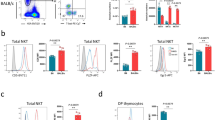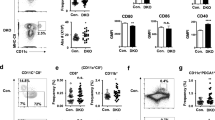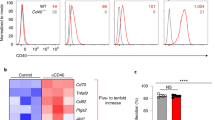Abstract
The differentiation of hematopoietic stem cells into mature blood cell lineages is tightly regulated. Here we report that CD27, which is expressed on stem and early progenitor cells in bone marrow, can be important in this process. Deletion of CD27 increased the myeloid colony–forming potential of stem and early progenitor cells and enhanced B lymphoid reconstitutive capacity in competitive transplantation experiments. Conversely, stimulation of CD27+ progenitor cells with CD70, the unique ligand for CD27, inhibited colony-forming potential in vitro and lymphocyte outgrowth in vivo. As CD70 is expressed only on activated immune cells, we suggest that CD27 triggering on early progenitor cells provides a negative feedback signal to leukocyte differentiation during immune activation.
This is a preview of subscription content, access via your institution
Access options
Subscribe to this journal
Receive 12 print issues and online access
$209.00 per year
only $17.42 per issue
Buy this article
- Purchase on Springer Link
- Instant access to full article PDF
Prices may be subject to local taxes which are calculated during checkout







Similar content being viewed by others
References
Fuchs, E., Tumbar, T. & Guasch, G. Socializing with the neighbors: stem cells and their niche. Cell 116, 769–778 (2004).
Calvi, L.M. et al. Osteoblastic cells regulate the haematopoietic stem cell niche. Nature 425, 841–846 (2003).
Zhang, J. et al. Identification of the haematopoietic stem cell niche and control of the niche size. Nature 425, 836–841 (2003).
Arai, F. et al. Tie2/angiopoietin-1 signaling regulates hematopoietic stem cell quiescence in the bone marrow niche. Cell 118, 149–161 (2004).
Kondo, M. et al. Biology of hematopoietic stem cells and progenitors: implications for clinical application. Annu. Rev. Immunol. 21, 759–806 (2003).
Wiesmann, A. et al. Expression of CD27 on murine hematopoietic stem and progenitor cells. Immunity 12, 193–199 (2000).
Igarashi, H., Gregory, S.C., Yokota, T., Sakaguchi, N. & Kincade, P.W. Transcription from the RAG1 locus marks the earliest lymphocyte progenitors in bone marrow. Immunity 17, 117–130 (2002).
de Jong, R. et al. Regulation of expression of CD27, a T cell-specific member of a novel family of membrane receptors. J. Immunol. 146, 2488–2494 (1991).
van Lier, R.A. et al. Tissue distribution and biochemical and functional properties of Tp55 (CD27), a novel T cell differentiation antigen. J. Immunol. 139, 1589–1596 (1987).
Hamann, D. et al. Phenotypic and functional separation of memory and effector human CD8+ T cells. J. Exp. Med. 186, 1407–1418 (1997).
Jacquot, S., Kobata, T., Iwata, S., Morimoto, C. & Schlossman, S.F. CD154/CD40 and CD70/CD27 interactions have different and sequential functions in T cell-dependent B cell responses: enhancement of plasma cell differentiation by CD27 signaling. J. Immunol. 159, 2652–2657 (1997).
Kobata, T. et al. CD27–CD70 interactions regulate B-cell activation by T cells. Proc. Natl. Acad. Sci. USA 92, 11249–11253 (1995).
Xiao, Y., Hendriks, J., Langerak, P., Jacobs, H. & Borst, J. CD27 is acquired by primed B cells at the centroblast stage and promotes germinal center formation. J. Immunol. 172, 7432–7441 (2004).
Klein, U., Rajewsky, K. & Kuppers, R. Human immunoglobulin (Ig)M+IgD+ peripheral blood B cells expressing the CD27 cell surface antigen carry somatically mutated variable region genes: CD27 as a general marker for somatically mutated (memory) B cells. J. Exp. Med. 188, 1679–1689 (1998).
Hintzen, R.Q. et al. Characterization of the human CD27 ligand, a novel member of the TNF gene family. J. Immunol. 152, 1762–1773 (1994).
Bowman, M.R. et al. The cloning of CD70 and its identification as the ligand for CD27. J. Immunol. 152, 1756–1761 (1994).
Lens, S.M., Baars, P.A., Hooibrink, B., van Oers, M.H. & van Lier, R.A. Antigen-presenting cell-derived signals determine expression levels of CD70 on primed T cells. Immunology 90, 38–45 (1997).
Oshima, H. et al. Characterization of murine CD70 by molecular cloning and mAb. Int. Immunol. 10, 517–526 (1998).
Akiba, H. et al. Critical contribution of OX40 ligand to T helper cell type 2 differentiation in experimental leishmaniasis. J. Exp. Med. 191, 375–380 (2000).
Tesselaar, K. et al. Expression of the murine CD27 ligand CD70 in vitro and in vivo. J. Immunol. 170, 33–40 (2003).
Hintzen, R.Q. et al. Engagement of CD27 with its ligand CD70 provides a second signal for T cell activation. J. Immunol. 154, 2612–2623 (1995).
Agematsu, K. et al. Generation of plasma cells from peripheral blood memory B cells: synergistic effect of interleukin-10 and CD27/CD70 interaction. Blood 91, 173–180 (1998).
Arens, R. et al. Constitutive CD27/CD70 interaction induces expansion of effector-type T cells and results in IFNγ-mediated B cell depletion. Immunity 15, 801–812 (2001).
Arens, R. et al. Tumor rejection induced by CD70-mediated quantitative and qualitative effects on effector CD8+ T cell formation. J. Exp. Med. 199, 1595–1605 (2004).
Hendriks, J. et al. CD27 is required for generation and long-term maintenance of T cell immunity. Nat. Immunol. 1, 433–440 (2000).
Hendriks, J., Xiao, Y. & Borst, J. CD27 promotes survival of activated T cells and complements CD28 in generation and establishment of the effector T cell pool. J. Exp. Med. 198, 1369–1380 (2003).
Ploemacher, R.E., van der Sluijs, J.P., van Beurden, C.A., Baert, M.R. & Chan, P.L. Use of limiting-dilution type long-term marrow cultures in frequency analysis of marrow-repopulating and spleen colony-forming hematopoietic stem cells in the mouse. Blood 78, 2527–2533 (1991).
Ikuta, K. & Weissman, I.L. Evidence that hematopoietic stem cells express mouse c-kit but do not depend on steel factor for their generation. Proc. Natl. Acad. Sci. USA 89, 1502–1506 (1992).
Orlic, D., Fischer, R., Nishikawa, S., Nienhuis, A.W. & Bodine, D.M. Purification and characterization of heterogeneous pluripotent hematopoietic stem cell populations expressing high levels of c-kit receptor. Blood 82, 762–770 (1993).
Li, C.L. & Johnson, G.R. Murine hematopoietic stem and progenitor cells: I. Enrichment and biologic characterization. Blood 85, 1472–1479 (1995).
Adolfsson, J. et al. Upregulation of Flt3 expression within the bone marrow Lin−Sca1+c-kit+ stem cell compartment is accompanied by loss of self-renewal capacity. Immunity 15, 659–669 (2001).
Christensen, J.L. & Weissman, I.L. Flk-2 is a marker in hematopoietic stem cell differentiation: a simple method to isolate long-term stem cells. Proc. Natl. Acad. Sci. USA 98, 14541–14546 (2001).
Kerst, J.M., Slaper-Cortenbach, I.C., van dem Borne, A.E., van der Schoot, C.E. & van Oers, R.H. Combined measurement of growth and differentiation in suspension cultures of purified human CD34-positive cells enables a detailed analysis of myelopoiesis. Exp. Hematol. 20, 1188–1193 (1992).
Lagasse, E. & Weissman, I.L. Flow cytometric identification of murine neutrophils and monocytes. J. Immunol. Methods 197, 139–150 (1996).
Kouro, T., Medina, K.L., Oritani, K. & Kincade, P.W. Characteristics of early murine B-lymphocyte precursors and their direct sensitivity to negative regulators. Blood 97, 2708–2715 (2001).
Akiba, H. et al. CD27, a member of the tumor necrosis factor receptor superfamily, activates NF-κB and stress-activated protein kinase/c-Jun N-terminal kinase via TRAF2, TRAF5, and NF-κB-inducing kinase. J. Biol. Chem. 273, 13353–13358 (1998).
Gravestein, L.A. et al. The TNF receptor family member CD27 signals to Jun N-terminal kinase via Traf-2. Eur. J. Immunol. 28, 2208–2216 (1998).
Feuerer, M. et al. Bone marrow as a priming site for T-cell responses to blood-borne antigen. Nat. Med. 9, 1151–1157 (2003).
Slifka, M.K., Matloubian, M. & Ahmed, R. Bone marrow is a major site of long-term antibody production after acute viral infection. J. Virol. 69, 1895–1902 (1995).
McHeyzer-Williams, M.G. & Ahmed, R. B cell memory and the long-lived plasma cell. Curr. Opin. Immunol. 11, 172–179 (1999).
Tarte, K., Zhan, F., De Vos, J., Klein, B. & Shaughnessy, J., Jr. Gene expression profiling of plasma cells and plasmablasts: toward a better understanding of the late stages of B-cell differentiation. Blood 102, 592–600 (2003).
Nagumo, H. et al. CD27/CD70 interaction augments IgE secretion by promoting the differentiation of memory B cells into plasma cells. J. Immunol. 161, 6496–6502 (1998).
Tokoyoda, K., Egawa, T., Sugiyama, T., Choi, B.I. & Nagasawa, T. Cellular niches controlling B lymphocyte behavior within bone marrow during development. Immunity 20, 707–718 (2004).
Zoumbos, N.C., Djeu, J.Y. & Young, N.S. Interferon is the suppressor of hematopoiesis generated by stimulated lymphocytes in vitro. J. Immunol. 133, 769–774 (1984).
Young, H.A. et al. Bone marrow and thymus expression of interferon-gamma results in severe B-cell lineage reduction, T-cell lineage alterations, and hematopoietic progenitor deficiencies. Blood 89, 583–595 (1997).
Bryder, D. et al. Self-renewal of multipotent long-term repopulating hematopoietic stem cells is negatively regulated by Fas and tumor necrosis factor receptor activation. J. Exp. Med. 194, 941–952 (2001).
Rebel, V.I. et al. Essential role for the p55 tumor necrosis factor receptor in regulating hematopoiesis at a stem cell level. J. Exp. Med. 190, 1493–1504 (1999).
Ploemacher, R.E. Cobblestone area forming cell (CAFC) assay. in Culture of Hematopoietic Cells vol. 1 (eds. Freshney R.I., Pragnell, I.B., Freshney, M.G.) 1–21 (Wiley-Liss, New York, New York, 1994).
Fibbe, W.E. et al. Sustained engraftment of mice transplanted with IL-1-primed blood-derived stem cells. J. Immunol. 148, 417–421 (1992).
Acknowledgements
We thank H. Hagoort and R. van Olffen for technical assistance; E. Nolte-'t Hoen (Imperial College London, London, UK), R. Mebius (VU Medical Center, Amsterdam, The Netherlands) and C. Reis e Sousa (Cancer Research UK, London, UK) for critical reading of the manuscript; and J. Borst (The Netherlands Cancer Institute, Amsterdam, The Netherlands) for providing CD27-deficient mice.
Author information
Authors and Affiliations
Corresponding author
Ethics declarations
Competing interests
The authors declare no competing financial interests.
Rights and permissions
About this article
Cite this article
Nolte, M., Arens, R., van Os, R. et al. Immune activation modulates hematopoiesis through interactions between CD27 and CD70. Nat Immunol 6, 412–418 (2005). https://doi.org/10.1038/ni1174
Received:
Accepted:
Published:
Issue Date:
DOI: https://doi.org/10.1038/ni1174
This article is cited by
-
The CD70-CD27 axis in oncology: the new kids on the block
Journal of Experimental & Clinical Cancer Research (2022)
-
LIGHT/LTβR signaling regulates self-renewal and differentiation of hematopoietic and leukemia stem cells
Nature Communications (2021)
-
Immune checkpoint blockade and CAR-T cell therapy in hematologic malignancies
Journal of Hematology & Oncology (2019)
-
Regulation of hematopoietic and leukemic stem cells by the immune system
Cell Death & Differentiation (2015)
-
CD27‐deficient mice show normal NK‐cell differentiation but impaired function upon stimulation
Immunology & Cell Biology (2011)



